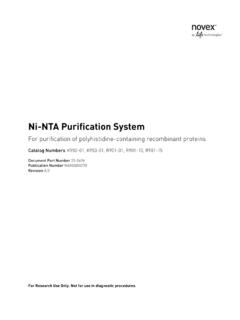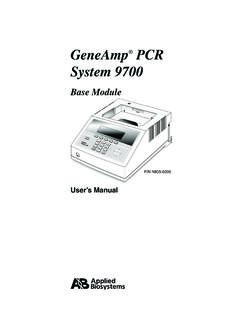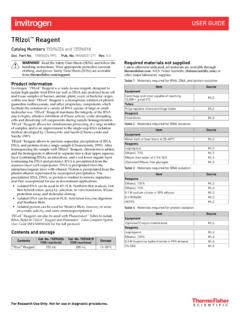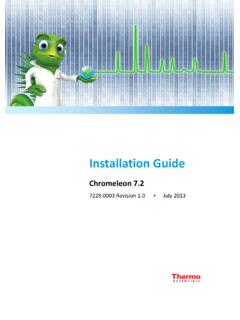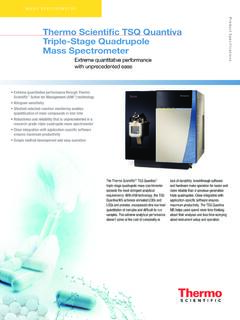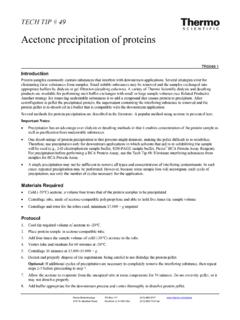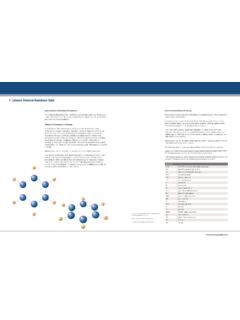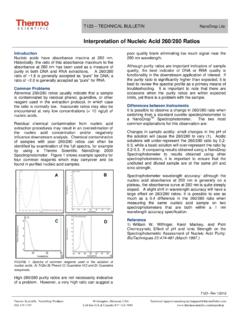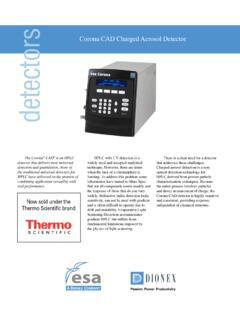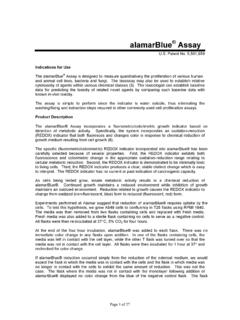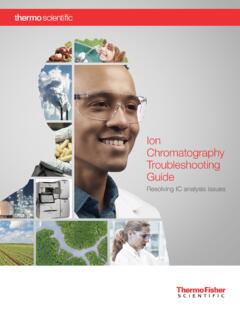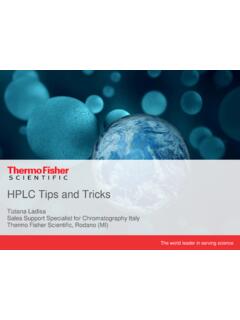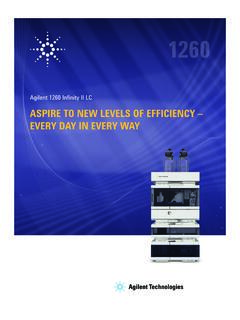Transcription of Quick Start Guide Chromeleon 7 - Thermo Fisher Scientific
1 Quick Start Guide Chromeleon 7 Thermo Scientific Chromeleon Software Version SR2 September 2012 Doc. No. , Rev. Chromeleon 7 Quick Start Guide Chromeleon 7 Quick Start Guide Page i Table of Contents Table of Contents i 1 Introduction 1 About this Document 1 Other Documentation 1 2 Using Chromeleon 2 Overview 2 Starting Chromeleon 3 Starting an Instrument 3 Making sure the Instrument Controller Service is Running 3 Establishing a Connection 5 Starting and Monitoring the Instrument 5 Creating a Sequence 7 Creating an Instrument Method 7 Creating a Processing Method 8 Creating a Report Template 8 Creating a Sequence 9 Acquiring Data 11 Starting an Analysis 11 Monitoring an Ongoing Analysis 12 Processing Data 13 Reviewing Chromatograms and Data 13 Detecting and Integrating Peaks 16 Identifying Peaks 22 Calibration 26 Review and Report Results 29 Reviewing Results 30 Printing Results 30 Chromeleon 7 Page ii Quick Start Guide 3 Appendix.
2 Chromeleon Overview 33 Introduction 33 Instrument Controller Service 34 Chromeleon Client 35 Chromeleon Console 35 chromatography Studio 41 Index 47 Chromeleon 7 Quick Start Guide Page iii 2012 Thermo Fisher Scientific Inc. All rights reserved. The information contained in this document is subject to change without notice. All rights reserved including those for photomechanical reproduction and storage on electronic media. No part of this publication may be copied or distributed, transmitted, transcribed, stored in a retrieval system, or transmitted into any human or computer language, in any form or by any means, electronic, mechanical, magnetic, manual, or otherwise, or disclosed to third parties without the express written permission of Thermo Fisher Scientific Inc. Trademarks Windows, Windows Vista, SQL Server 2008, SQL Server, and Microsoft are registered trademarks of Microsoft Corporation.
3 All other trademarks are property of Thermo Fisher Scientific Inc. and its subsidiariesChromeleon 7 Quick Start Guide Page 1 1 Introduction About this Document The Quick Start Guide is designed to provide a Quick reference to starting to work with Chromeleon . It is recommended that you review the Quick Start Guide thoroughly before working with Chromeleon . The Quick Start Guide has two parts: Using Chromeleon Guidance in starting a simple analysis, processing the data, and reporting the results. Appendix: Chromeleon Overview An overview of the Chromeleon interfaces and common features. This Quick Start Guide is provided "as is". Every effort has been made to supply complete and accurate information and all technical specifications and programs have been developed with the utmost care. However, Thermo Fisher Scientific assumes no responsibility and cannot be held liable for any errors, omissions, damage, or loss that might result from any use of this manual or the information contained in it.
4 Other Documentation Chromeleon is provided with other documents that will help you to learn more about the software. Their scope is described in the Document Overview, which is delivered in printed form with the Chromeleon installation media, but also available in electronic form on the installation disk in the Documents folder. Chromeleon 7 Page 2 Quick Start Guide 2 Using Chromeleon Overview Every analysis using Chromeleon follows the same 6 basic steps: 1. Start Chromeleon 2. Start the Instrument 3. Create a Sequence 4. Acquire Data 5. Process Data 6. Review and Report Results This Quick Start Guide provides enough information to perform each of these 6 steps as part of a simple analysis. For more advanced use of Chromeleon , including performing more complex analyses, please refer to Chromeleon Help or the Chromeleon User Guide .
5 Note: It is assumed that Chromeleon has been installed and at least one instrument has been connected and configured. For details on installation, connecting and configuring instruments see the Installation Guide . Chromeleon 7 Quick Start Guide Page 3 Starting Chromeleon To Start the Chromeleon software either: Double click the Chromeleon 7 icon on the desktop: Use the Windows Start menu: Select Start > All Programs > Chromeleon 7 > Chromeleon 7 The Chromeleon Console window opens. If user management is active, you will be prompted to log in to the software; enter the credentials provided by your Chromeleon adminstrator to proceed. Starting an Instrument To Start and monitor an instrument you must: Make sure the Instrument Controller service is running Establish a connection Start and monitor the instrument Making sure the Instrument Controller Service is Running The Chromeleon Instrument Controller Service handles instrument communications, control, and data acquisition.
6 It runs in the background as a Windows service on any PC to which instruments are physically connected. Its status is represented by an icon in the Notification Area of the Windows Taskbar. Chromeleon 7 Page 4 Quick Start Guide Figure 1 : Notification Area of Windows Taskbar for Windows XP and Windows 7 Instrument Controller Service is stopped Instrument Controller Service is running If the Instrument Controller Service is stopped, Start it by following these steps: 1. Right-click the Chromeleon tray icon in the notification area of the Windows task bar. 2. Click Start Chromeleon Instrument Controller. Tip: If the Chromeleon tray icon is not visible on the task bar, click Start , point to Programs (or All Progams, depending on the operating system) and Chromeleon 7, and click Services Manager. Note: You can configure the Chromeleon Instrument Controller Service to automatically Start every time the computer is switched on.
7 See the Controlling Instruments and Modules section of the Chromeleon Help for more information. Chromeleon 7 Quick Start Guide Page 5 Establishing a Connection Before you can control an instrument, communication must be established between the Modules and the Chromeleon Instrument Controller. This is referred to as Connecting the Modules . To connect the chromatography modules follow these steps: 1. In the Console, choose the Instruments category and click your instrument s name in the Navigation Pane. 2. Select the ePanel tab for the required module in the Work Area (for example Pump). 3. On the ePanel, click Connect. Note: The ePanel sets are generated automatically to support modules from a specific instrument series ( , UltiMate 3000, ICS-5000). When combining modules from these instruments, ePanels for some modules may not be displayed automatically.
8 See Managing ePanel Sets and ePanels in Chromeleon Help for details on manually adding ePanels to a set. Starting and Monitoring the Instrument To Start the instrument modules follow these steps: 1. In the Console, choose the Instruments category. Select the instrument by clicking its name in the Navigation Pane. 2. In the Work Area select the ePanel tab for the required module. 3. Use the controls on the ePanel to issue instrument commands (for example setting the wavelength of a UV/VIS detector or starting mobile phase flow on a pump). Chromeleon 7 Page 6 Quick Start Guide You can monitor instrument parameters and outputs such as the detector signal output or pump pressure from the module s ePanel. Note: Most common commands are available from the ePanels. If you need to execute a command that is not available you can access all available instrument commands from a dialog that is accessible via the commands button in the Instruments toolbar.
9 Tip: For certain instruments, Chromeleon provides procedures for automatically starting or shutting down a chromatography system, or setting it into standby mode. These procedures are referred to as Smart Startup, Smart Shutdown, and Smart Standby, respectively. For details of which instruments can be controlled in this way and how to use this funtionality see Smart Startup, Smart Shutdown, and Smart Standby in Chromeleon Help. Chromeleon 7 Quick Start Guide Page 7 Creating a Sequence A sequence determines how a group of injections should be processed. The injection list is the primary element of the sequence. The list groups injections in the order in which they will be processed and includes injection variables (name, type, etc.) that characterize each injection. Sequences can be created in the Console or by using an eWorkflow.
10 EWorkflows are simple but powerful tools for creating sequences based on pre-defined templates and rules. For more information on creating and using eWorkflows see Creating eWorkflows in Chromeleon Help. You create a sequence using the Sequence Wizard within the Console. But first, the following files should be prepared: Instrument Method Processing Method Report Template Creating an Instrument Method 1. In the Console, on the Create menu, click Instrument Method. 2. If you have multiple instruments, select the instrument for which you want to create the Instrument Method and click Next. 3. Complete all wizard steps and click Finish. The created Instrument Method opens in the chromatography Studio. 4. Review the Instrument Method by selecting the module views in the navigation pane. Edit settings, if required. Chromeleon 7 Page 8 Quick Start Guide 5.
